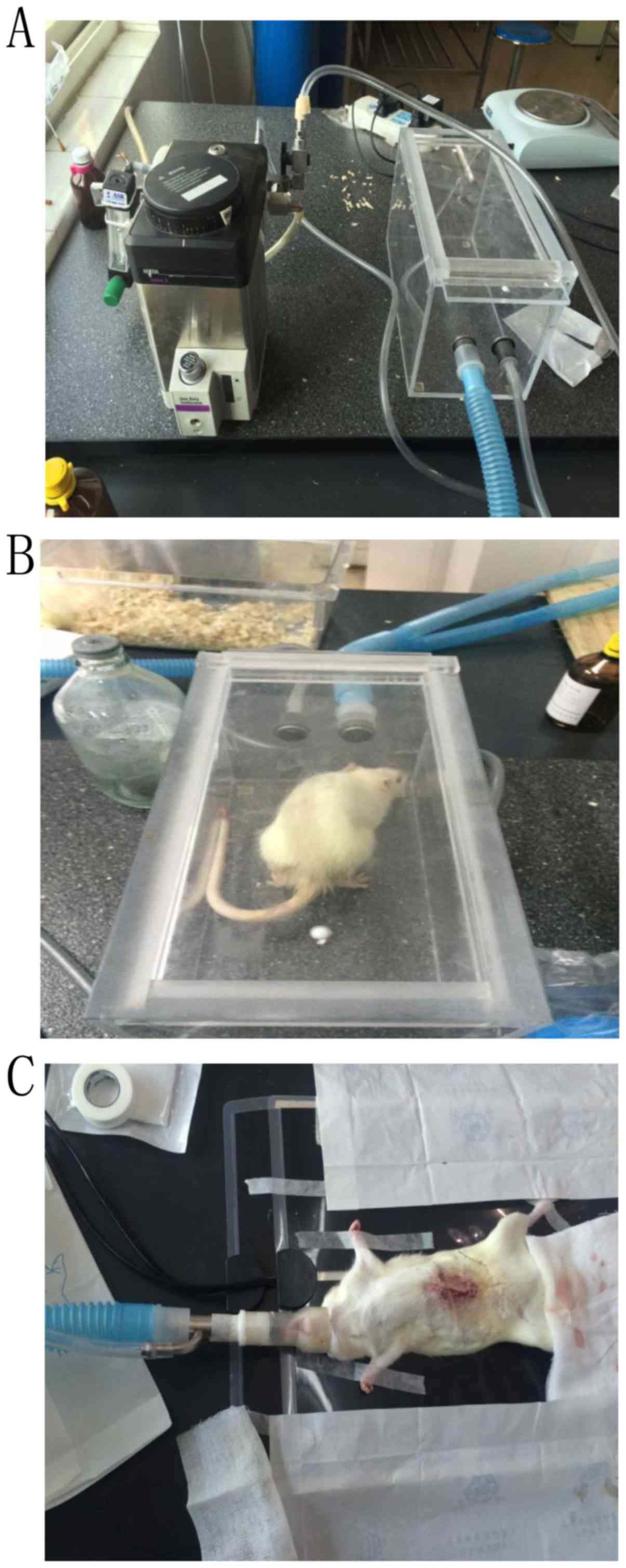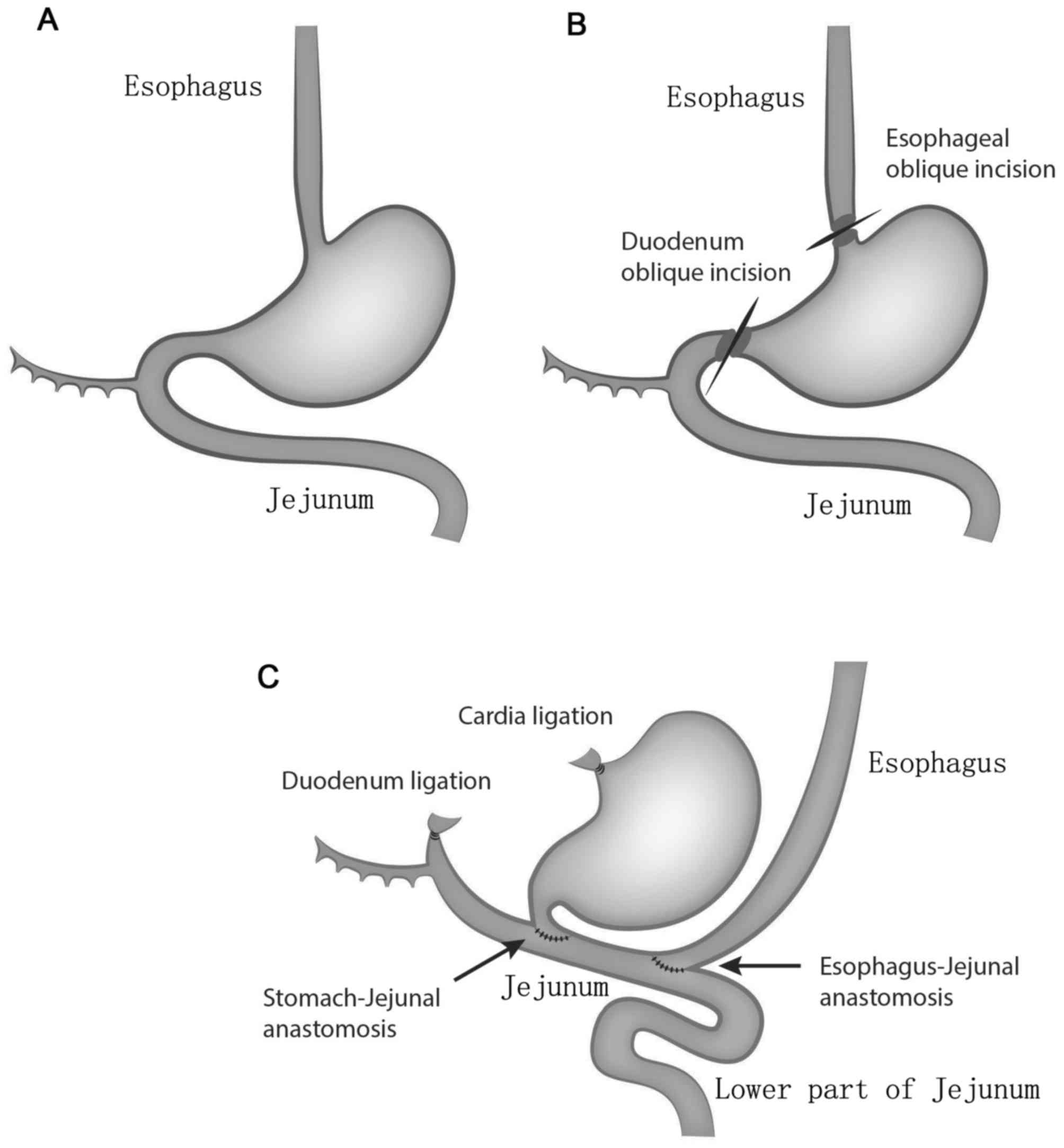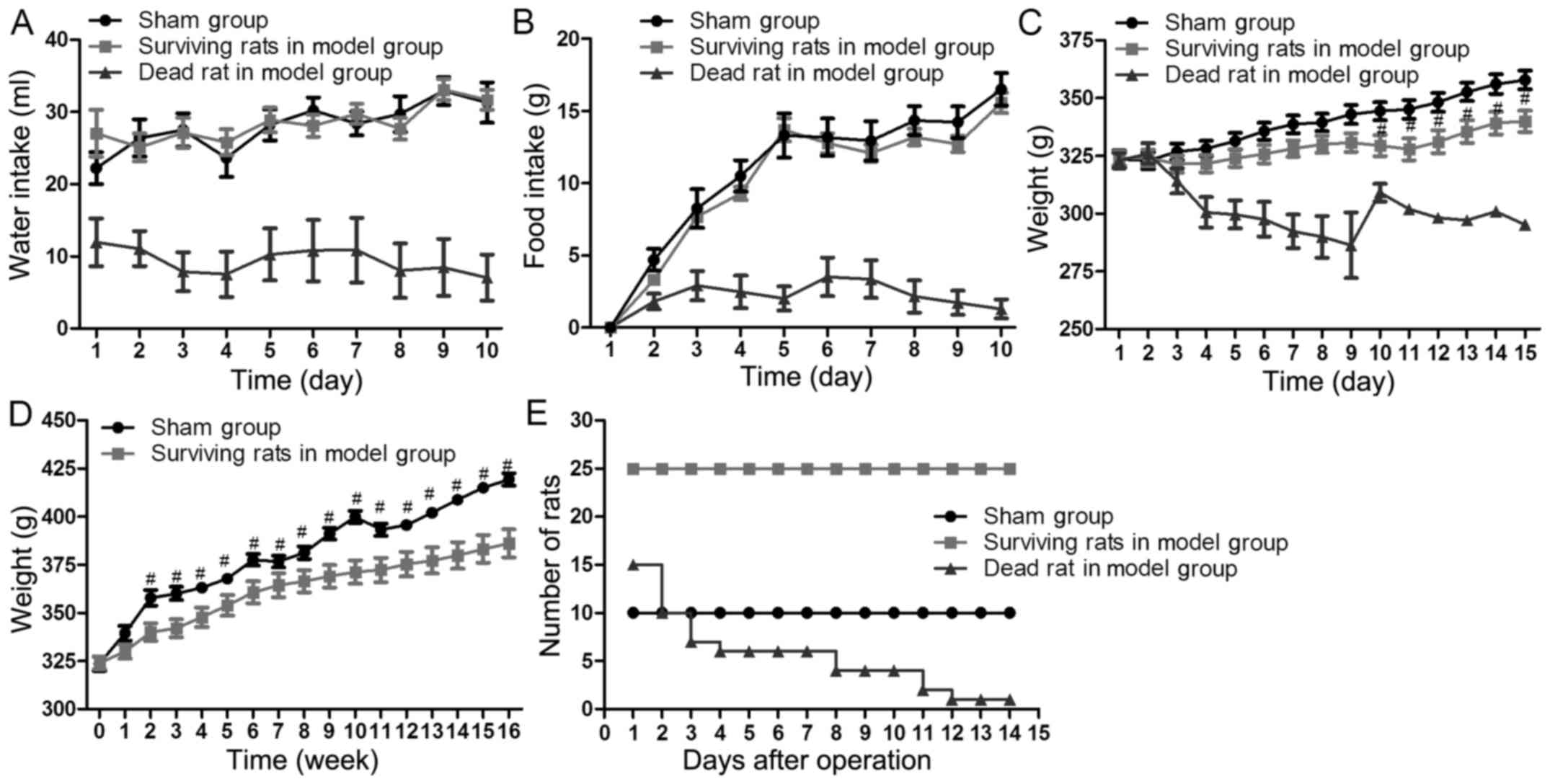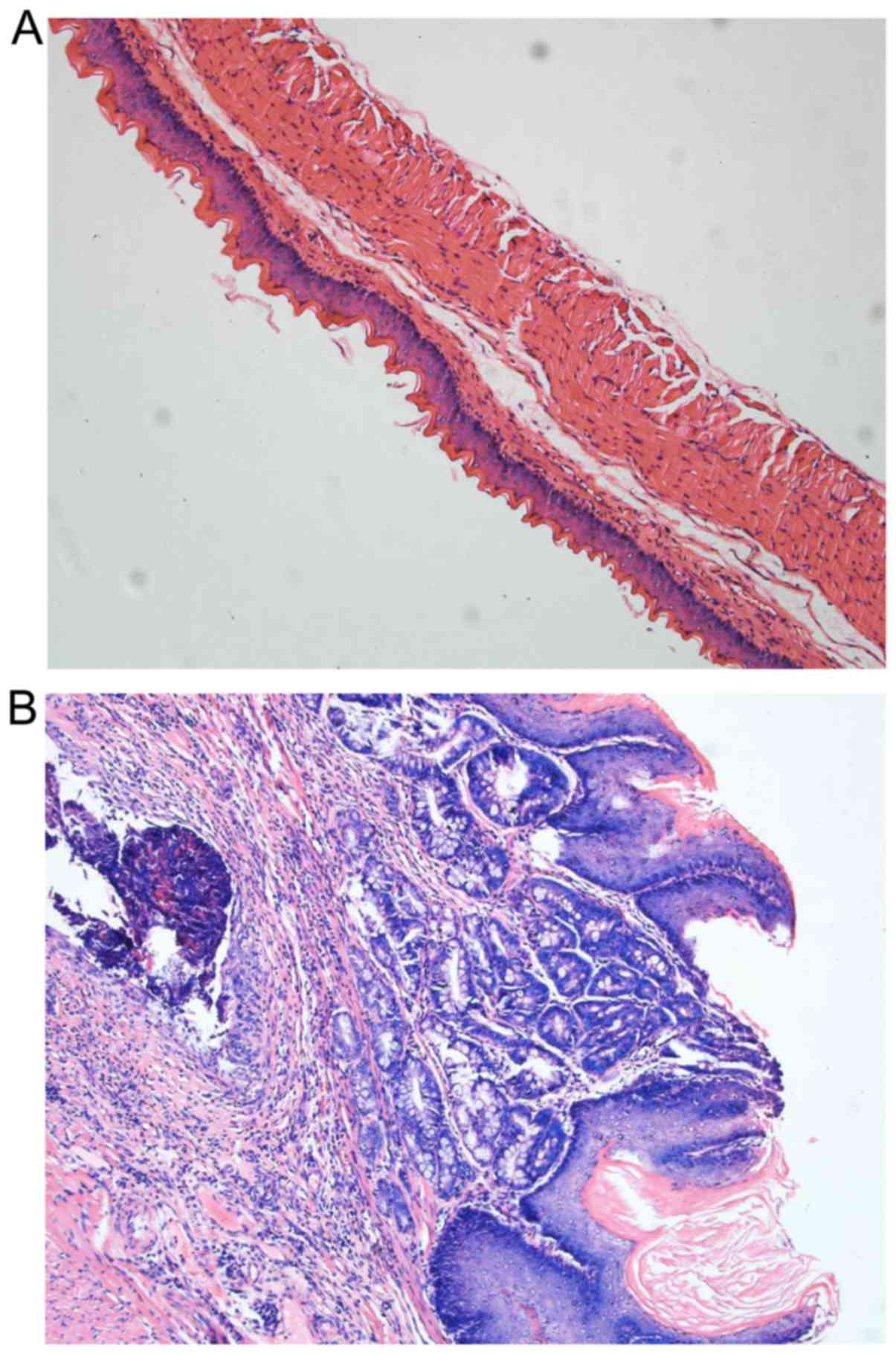|
1
|
El-Serag HB, Sweet S, Winchester CC and
Dent J: Update on the epidemiology of gastro-oesophageal reflux
disease: A systematic review. Gut. 63:871–880. 2014. View Article : Google Scholar : PubMed/NCBI
|
|
2
|
Rubenstein JH and Shaheen NJ:
Epidemiology, diagnosis, and management of esophageal
adenocarcinoma. Gastroenterology. 149(302–317): e12015.
|
|
3
|
Altorki NK, Oliveria S and Schrump DS:
Epidemiology and molecular biology of Barrett's adenocarcinoma.
Semin Surg Oncol. 13:270–280. 1997. View Article : Google Scholar : PubMed/NCBI
|
|
4
|
Isolauri J, Luostarinen M, Isolauri E,
Reinikainen P, Viljakka M and Keyriläinen O: Natural course of
gastroesophageal reflux disease: 17–22 year follow-up of 60
patients. Am J Gastroenterol. 92:37–41. 1997.PubMed/NCBI
|
|
5
|
Wani S, Rubenstein JH, Vieth M and Bergman
J: Diagnosis and management of low-grade dysplasia in barrett's
esophagus: Expert review from the clinical practice updates
committee of the American gastroenterological association.
Gastroenterology. 151:822–835. 2016. View Article : Google Scholar : PubMed/NCBI
|
|
6
|
Phillips WA, Lord RV, Nancarrow DJ, Watson
DI and Whiteman DC: Barrett's esophagus. J Gastroenterol Hepatol.
26:639–648. 2011. View Article : Google Scholar : PubMed/NCBI
|
|
7
|
Grant KS, DeMeester SR, Kreger V, Oh D,
Hagen JA, Chandrasoma P and DeMeester TR: Effect of Barrett's
esophagus surveillance on esophageal preservation, tumor stage, and
survival with esophageal adenocarcinoma. J Thorac Cardiovasc Surg.
146:31–37. 2013. View Article : Google Scholar : PubMed/NCBI
|
|
8
|
Pera M, Cardesa A, Bombi JA, Ernst H, Pera
C and Mohr U: Influence of esophagojejunostomy on the induction of
adenocarcinoma of the distal esophagus in Sprague-Dawley rats by
subcutaneous injection of 2,6-dimethylnitrosomorpholine. Cancer
Res. 49:6803–6808. 1989.PubMed/NCBI
|
|
9
|
Fein M, Peters JH, Chandrasoma P, Ireland
AP, Oberg S, Ritter MP, Bremner CG, Hagen JA and DeMeester TR:
Duodenoesophageal reflux induces esophageal adenocarcinoma without
exogenous carcinogen. J Gastrointest Surg. 2:260–268. 1998.
View Article : Google Scholar : PubMed/NCBI
|
|
10
|
Attwood SE, Smyrk TC, DeMeester TR,
Mirvish SS, Stein HJ and Hinder RA: Duodenoesophageal reflux and
the development of esophageal adenocarcinoma in rats. Surgery.
111:503–510. 1992.PubMed/NCBI
|
|
11
|
Miwa K, Sahara H, Segawa M, Kinami S, Sato
T, Miyazaki I and Hattori T: Reflux of duodenal or gastro-duodenal
contents induces esophageal carcinoma in rats. Int J Cancer.
67:269–274. 1996. View Article : Google Scholar : PubMed/NCBI
|
|
12
|
Ireland AP, Peters JH, Smyrk TC, DeMeester
TR, Clark GW, Mirvish SS and Adrian TE: Gastric juice protects
against the development of esophageal adenocarcinoma in the rat.
Ann Surg. 224:358–371. 1996. View Article : Google Scholar : PubMed/NCBI
|
|
13
|
Mirvish SS: Studies on experimental
animals involving surgical procedures and/or nitrosamine treatment
related to the etiology of esophageal adenocarcinoma. Cancer Lett.
117:161–174. 1997. View Article : Google Scholar : PubMed/NCBI
|
|
14
|
Goldstein SR, Yang GY, Curtis SK, Reuhl
KR, Liu BC, Mirvish SS, Newmark HL and Yang CS: Development of
esophageal metaplasia and adenocarcinoma in a rat surgical model
without the use of a carcinogen. Carcinogenesis. 18:2265–2270.
1997. View Article : Google Scholar : PubMed/NCBI
|
|
15
|
Nishijima K, Miwa K, Miyashita T, Kinami
S, Ninomiya I, Fushida S, Fujimura T and Hattori T: Impact of the
biliary diversion procedure on carcinogenesis in Barrett's
esophagus surgically induced by duodenoesophageal reflux in rats.
Ann Surg. 240:57–67. 2004. View Article : Google Scholar : PubMed/NCBI
|
|
16
|
Su Y, Chen X, Klein M, Fang M, Wang S,
Yang CS and Goyal RK: Phenotype of columnar-lined esophagus in rats
with esophagogastroduodenal anastomosis: Similarity to human
Barrett's esophagus. Lab Invest. 84:753–765. 2004. View Article : Google Scholar : PubMed/NCBI
|
|
17
|
Zhang T, Zhang F, Han Y, Gu Z, Zhou Y,
Cheng Q, Zhu Y, Zhang C and Wang Y: A rat surgical model of
esophageal metaplasia and adenocarcinoma-induced by mixed reflux of
gastric acid and duodenal contents. Dig Dis Sci. 52:3202–3208.
2007. View Article : Google Scholar : PubMed/NCBI
|
|
18
|
Shaheen NJ, Falk GW, Iyer PG and Gerson
LB: American College of Gastroenterology: ACG clinical guideline:
Diagnosis and management of Barrett's esophagus. Am J
Gastroenterol. 111:30–50; quiz 51. 2016. View Article : Google Scholar : PubMed/NCBI
|
|
19
|
Farré R: Pathophysiology of
gastro-esophageal reflux disease: A role for mucosa integrity?
Neurogastroenterol Motil. 25:783–799. 2013.PubMed/NCBI
|
|
20
|
Vaezi MF and Richter JE: Role of acid and
duodenogastroesophageal reflux in gastroesophageal reflux disease.
Gastroenterology. 111:1192–1199. 1996. View Article : Google Scholar : PubMed/NCBI
|
|
21
|
Theisen J, Peters JH, Fein M, Hughes M,
Hagen JA, Demeester SR, Demeester TR and Laird PW: The mutagenic
potential of duodenoesophageal reflux. Ann Surg. 241:63–68.
2005.PubMed/NCBI
|
|
22
|
Champion G, Richter JE, Vaezi MF, Singh S
and Alexander R: Duodenogastroesophageal reflux: Relationship to pH
and importance in Barrett's esophagus. Gastroenterology.
107:747–754. 1994. View Article : Google Scholar : PubMed/NCBI
|
|
23
|
Marshall RE, Anggiansah A, Owen WA and
Owen WJ: Investigation of gastro-oesophageal reflux in patients
with an intact stomach: Is oesophageal bilirubin monitoring a
useful addition to pH monitoring? Scand J Gastroenterol.
35:904–909. 2000. View Article : Google Scholar : PubMed/NCBI
|
|
24
|
Vaezi MF and Richter JE: Synergism of acid
and duodenogastroesophageal reflux in complicated Barrett's
esophagus. Surgery. 117:699–704. 1995. View Article : Google Scholar : PubMed/NCBI
|
|
25
|
Sun D, Wang X, Gai Z, Song X, Jia X and
Tian H: Bile acids but not acidic acids induce Barrett's esophagus.
Int J Clin Exp Pathol. 8:1384–1392. 2015.PubMed/NCBI
|
|
26
|
Cheng P, Li JS, Gong J, Zhang LF and Chen
RZ: Effects of refluxate pH values on duodenogastroesophageal
reflux-induced esophageal adenocarcinoma. World J Gastroenterol.
17:3060–3065. 2011. View Article : Google Scholar : PubMed/NCBI
|
|
27
|
Uno K, Iijima K, Hatta W, Koike T, Abe Y,
Asano N, Kusaka G and Shimosegawa T: Direct measurement of
gastroesophageal reflux episodes in patients with squamous cell
carcinoma by 24-h pH-impedance monitoring. Am J Gastroenterol.
106:1923–1929. 2011. View Article : Google Scholar : PubMed/NCBI
|


















